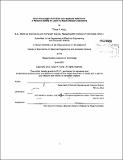How knowledge of context and radicals influences a person's ability to learn to read Chinese characters
Author(s)
Kortz, Tanya M
DownloadFull printable version (3.644Mb)
Other Contributors
Massachusetts Institute of Technology. Dept. of Electrical Engineering and Computer Science.
Advisor
Patrick H. Winston.
Terms of use
Metadata
Show full item recordAbstract
Learning a new language is not always easy. This is particularly the case for native English speakers, who are used to letters combining to form words and tones expressing emotion, trying to learn Chinese. Mandarin Chinese is a logographic language, meaning that each character represents a word and voice tone is used to differentiate between what would otherwise be homophones. In this thesis, I present two hypothesized methods for improving a student's ability to learn to recognize Chinese characters. The first is the use of radicals, components that make up Chinese characters almost like letters make up English words. The second is the use of studying example sentences when learning new words. To test these hypotheses, I performed a pilot experiment using 10 MIT undergraduate students, none of whom were native speakers of Mandarin Chinese. There were not enough Chinese II students to test the second hypotheses, but the results suggest that the use of radicals does improve a student's ability to learn to recognize characters both more correctly and more quickly.
Description
Thesis (M. Eng.)--Massachusetts Institute of Technology, Dept. of Electrical Engineering and Computer Science, 2012. Cataloged from PDF version of thesis. Includes bibliographical references (p. 36).
Date issued
2012Department
Massachusetts Institute of Technology. Department of Electrical Engineering and Computer SciencePublisher
Massachusetts Institute of Technology
Keywords
Electrical Engineering and Computer Science.